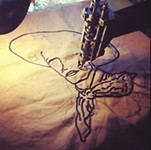After a Fashion
Local roboticist Brooks Coleman walks the line between art and fashion with his line of sheet metal lingere.
By Stephen MacMillan Moser, Fri., Feb. 18, 2000
The "garments" spiral around the breasts in serpentine patterns, or enclose the chest in a series of plates like a prehistoric animal. Some are strips of metal woven and twisted with electro-luminescent tubing that glows like neon. Some have tubing injected with a syringe that pumps and pulsates colored or glow-in-the-dark liquids through a network coursing across the chest. Some are embossed and etched with intricate motifs, and some are like chain mail. Some don't have quite as many bells and whistles, relying on pure form to make their statement. But designs like these always inspire the question, "Who is your customer?" As a designer of goods like these, you'd be at the top of your class to get Cher or Madonna to wear your things, and then, of course, you have the girls at the Cheetah -- I mean the Yellow Rose. But are there enough of those customers to support a business? Coleman says he could quickly mass-produce the garments, but who, in between the strippers and the superstars, is going to wear these things? And how many of these things are the strippers and the superstars going to need? Perhaps the inherent danger in designing work like this is in being unable to bridge the gap between function and fashion. Outside of cocktail hour in Sodom & Gomorrah, my mind draws a blank when I try and think of an occasion that requires a metal bra, but high fashion was never about necessity. There's always been the segment of fashion that is more accurately described as "wearable art." And though wearable art got a really skanky reputation with sweatshirts decorated with puff paint and glitter glue, wearable art is, in its purest form, art.
Perhaps Mr. Coleman would be wise to approach these designs as art and not fashion. I have a friend with whom I went to design school who paints magnificent designs on silk. She struggled for years trying to sell clothes and scarves out of the fabric, with little success. When she started mounting the fabric on padded plywood and selling it as art, her sales skyrocketed, she left the clothing business behind in the dirt, and now she's a respected artist with works going for thousands of dollars apiece. (It is one of the vagaries of the business that we cannot be taken seriously as artists -- but of course, we don't make art, all we do is make clothes.) The creativity is amazing in Coleman's wearable works of art -- and that's what they must be considered, for they have moments of genius. They have a couture sensibility as far as the idea of the designs go, and certainly as far as his metalworking techniques go, but Coleman would benefit immensely by forming a collaboration with a professional clothing designer who could provide the proper finishing work that could take the collection out of a strip club and put it into an art gallery. And into the theatres. And on the girls at the Cheetah -- I mean the Yellow Rose. And even into the press. Where it belongs.
Write to our Style Avatar with your related events, news, and hautey bits: [email protected] or PO Box 49066, Austin, 78765 or 458-6910 (fax).








